

Dr. Troy Rowan
Assistant Professor
UTIA Genomics Center for the Advancement of Agriculture
P: 865-974-3190
As many of you know, Dr. Justin Rhinehart has transitioned from his Extension Specialist position into administration at UTIA as the Assistant Dean of Extension. As with any death in the family, there have been a series of “inheritances” passed out to the other specialists in the Animal Science Department. This column in Tennessee Cattle Business is one of those things that I inherited. As such, I’d like to devote this first piece to the thing that Justin and I talked about and agreed on the most: The absolute necessity of crossbreeding in commercial cowherds.
As the margins in our industry get thinner and thinner, easy opportunities to generate additional profit are few and far between. Crossbreeding is the exception to this rule and really is the last “free lunch” left in the beef industry, but it remains severely under-utilized.
Crossbreeding gives us an advantage on two fronts: breed complementarity and heterosis. Breed complementarity is exactly what it sounds like. When we cross breeds with complementary strengths, we can get the “best of both worlds” and stack favorable traits on top of each other. This might look like matching the lean muscle growth of a Charolais with the higher marbling of an Angus animal or the maternal ability of a Hereford with the performance of a Simmental. In certain hot and humid environments, using a Bos indicus breed in a crossbreeding program can add climate adaptability while maintaining a British breed’s carcass and maternal abilities.
The second major advantage to crossbreeding is added performance across traits resulting from heterosis or hybrid vigor. We’ve known for a long time that when we breed two individuals from different populations, their offspring’s performance tends to be higher than the average of the two parental lines. This advantage in performance that we see in the crossbred offspring is what we refer to as heterosis.
The amount of heterosis that occurs is a function of how diverged the two parent breeds are and the heritability of the trait in question. The more distantly related two breeds are, the more heterosis we would expect to see from their crossbred offspring. For example, crossing a Red Angus and a Black Angus (breed split occurred about 70 years ago) would result in much lower levels of heterosis than crossing an Angus and a Brahman (Bos indicus and Bos taurus populations split about 250,000 years ago).
As far as traits go, heterosis is inversely related to heritability. This means that traits where genetics play a smaller role (think fertility, cow longevity, and health) experience more significant boosts due to heterosis. This is where Justin and I really came together on this crossbreeding topic. The advantage in fertility, longevity, and health that crossbred females provide is something that commercial cow-calf operations can’t afford not to take advantage of from a production and reproduction standpoint. For traits with low heritabilities, we can see crossbred benefits of over 20%. This could mean an extra 20% of crossbred heifers getting pregnant or an extra calf throughout a crossbred cow’s lifetime. Crossbred females are the cornerstones of a profitable commercial cowherd. They are productive longer, stay healthier, and breed back quicker.
While heterosis plays a more prominent role in lowly heritable traits, it also affects other traits. For moderately heritable traits that generate revenue, like weaning weight, the crossbred advantage can be around 5-10%. We’re leaving this free money on the table if we aren’t crossbreeding!
We can take advantage of crossbreeding in multiple ways, from utilizing a hybrid bull to a multi-breed rotational crossbreeding program. The more complex a crossbreeding program, the more heterosis we retain from generation to generation. We will save the discussion on crossbreeding programs for another article but know that there is something that can fit every commercial operation.
I’m all for easy solutions to complex problems, and when it comes to breeding cattle, there is not a more universally advantageous solution to increasing the profitability and productivity of a commercial cowherd than crossbreeding.